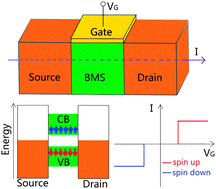Bipolar magnetic materials for electrical manipulation of spin-polarization orientation
Abstract
In spintronics, both the charge and spin of the electrons are exploited for information processing. Developing simple methods to manipulate and detect the carriers' spin orientation is among the key issues for spintronics applications. Electrical field has the advantage that it can be easily applied locally in contrast with a conventionally used magnetic field, thus it is more convenient and efficient. Bipolar magnetic materials, characterized by a unique electronic structure where the valence band and conduction band possess opposite spin polarization around the Fermi level, serve as a new class of materials for spintronics through which electrical control of spin-polarization direction can be realized simply by applying a gate voltage. This article reviews a range of materials that have bipolar spin polarization, including bipolar half metals and bipolar magnetic semiconductors, and their potential applications for creating, manipulating, and detecting spin-polarized carriers. These materials provide a promising future for electrically controllable spintronics devices.


 Please wait while we load your content...
Please wait while we load your content...